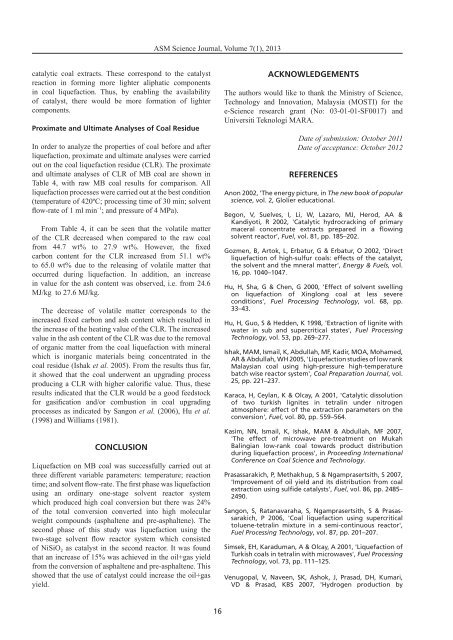Contents - Akademi Sains Malaysia
Contents - Akademi Sains Malaysia
Contents - Akademi Sains Malaysia
- No tags were found...
You also want an ePaper? Increase the reach of your titles
YUMPU automatically turns print PDFs into web optimized ePapers that Google loves.
ASM Science Journal, Volume 7(1), 2013catalytic coal extracts. These correspond to the catalystreaction in forming more lighter aliphatic componentsin coal liquefaction. Thus, by enabling the availabilityof catalyst, there would be more formation of lightercomponents.Proximate and Ultimate Analyses of Coal ResidueIn order to analyze the properties of coal before and afterliquefaction, proximate and ultimate analyses were carriedout on the coal liquefaction residue (CLR). The proximateand ultimate analyses of CLR of MB coal are shown inTable 4, with raw MB coal results for comparison. Allliquefaction processes were carried out at the best condition(temperature of 420ºC; processing time of 30 min; solventflow-rate of 1 ml min –1 ; and pressure of 4 MPa).From Table 4, it can be seen that the volatile matterof the CLR decreased when compared to the raw coalfrom 44.7 wt% to 27.9 wt%. However, the fixedcarbon content for the CLR increased from 51.1 wt%to 65.0 wt% due to the releasing of volatile matter thatoccurred during liquefaction. In addition, an increasein value for the ash content was observed, i.e. from 24.6MJ/kg to 27.6 MJ/kg.The decrease of volatile matter corresponds to theincreased fixed carbon and ash content which resulted inthe increase of the heating value of the CLR. The increasedvalue in the ash content of the CLR was due to the removalof organic matter from the coal liquefaction with mineralwhich is inorganic materials being concentrated in thecoal residue (Ishak et al. 2005). From the results thus far,it showed that the coal underwent an upgrading processproducing a CLR with higher calorific value. Thus, theseresults indicated that the CLR would be a good feedstockfor gasification and/or combustion in coal upgradingprocesses as indicated by Sangon et al. (2006), Hu et al.(1998) and Williams (1981).CONCLUSIONLiquefaction on MB coal was successfully carried out atthree different variable parameters: temperature; reactiontime; and solvent flow-rate. The first phase was liquefactionusing an ordinary one-stage solvent reactor systemwhich produced high coal conversion but there was 24%of the total conversion converted into high molecularweight compounds (asphaltene and pre-asphaltene). Thesecond phase of this study was liquefaction using thetwo-stage solvent flow reactor system which consistedof NiSiO 2 as catalyst in the second reactor. It was foundthat an increase of 15% was achieved in the oil+gas yieldfrom the conversion of asphaltene and pre-asphaltene. Thisshowed that the use of catalyst could increase the oil+gasyield.ACKNOWLEDGEMENTSThe authors would like to thank the Ministry of Science,Technology and Innovation, <strong>Malaysia</strong> (MOSTI) for thee-Science research grant (No: 03-01-01-SF0017) andUniversiti Teknologi MARA.Date of submission: October 2011Date of acceptance: October 2012REFERENCESAnon 2002, 'The energy picture, in The new book of popularscience, vol. 2, Glolier educational.Begon, V, Suelves, I, Li, W, Lazaro, MJ, Herod, AA &Kandiyoti, R 2002, 'Catalytic hydrocracking of primarymaceral concentrate extracts prepared in a flowingsolvent reactor’, Fuel, vol. 81, pp. 185–202.Gozmen, B, Artok, L, Erbatur, G & Erbatur, O 2002, 'Directliquefaction of high-sulfur coals: effects of the catalyst,the solvent and the mneral matter', Energy & Fuels, vol.16, pp. 1040–1047.Hu, H, Sha, G & Chen, G 2000, 'Effect of solvent swellingon liquefaction of Xinglong coal at less severeconditions', Fuel Processing Technology, vol. 68, pp.33–43.Hu, H, Guo, S & Hedden, K 1998, 'Extraction of lignite withwater in sub and supercritical states', Fuel ProcessingTechnology, vol. 53, pp. 269–277.Ishak, MAM, Ismail, K, Abdullah, MF, Kadir, MOA, Mohamed,AR & Abdullah, WH 2005, 'Liquefaction studies of low rank<strong>Malaysia</strong>n coal using high-pressure high-temperaturebatch wise reactor system', Coal Preparation Journal, vol.25, pp. 221–237.Karaca, H, Ceylan, K & Olcay, A 2001, 'Catalytic dissolutionof two turkish lignites in tetralin under nitrogenatmosphere: effect of the extraction parameters on theconversion', Fuel, vol. 80, pp. 559–564.Kasim, NN, Ismail, K, Ishak, MAM & Abdullah, MF 2007,'The effect of microwave pre-treatment on MukahBalingian low-rank coal towards product distributionduring liquefaction process', in Proceeding InternationalConference on Coal Science and Technology.Prasassarakich, P, Methakhup, S & Ngamprasertsith, S 2007,'Improvement of oil yield and its distribution from coalextraction using sulfide catalysts', Fuel, vol. 86, pp. 2485–2490.Sangon, S, Ratanavaraha, S, Ngamprasertsith, S & Prasassarakich,P 2006, 'Coal liquefaction using supercriticaltoluene-tetralin mixture in a semi-continuous reactor',Fuel Processing Technology, vol. 87, pp. 201–207.Simsek, EH, Karaduman, A & Olcay, A 2001, 'Liquefaction ofTurkish coals in tetralin with microwaves', Fuel ProcessingTechnology, vol. 73, pp. 111–125.Venugopal, V, Naveen, SK, Ashok, J, Prasad, DH, Kumari,VD & Prasad, KBS 2007, 'Hydrogen production by16
















